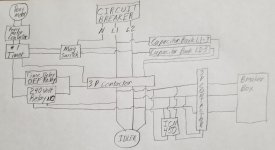Madmachinest---- To drop the voltage to the 160-170 range would mean you were starting a load too large for your system and have a severe overload.
JST some more questions. in a different thread--- (
https://www.practicalmachinist.com/...former-phase-converter-375393/index4.html)--- ----you stated:
"I would suggest an autoformer that boosts the generated leg to be perhaps 5% to 10% high at no load, which will probably still be reasonable compared to the pass-thru voltage with a heavy load.
That, so long as the autoformer does not add too much impedance (don't skimp on the VA), would seem to be the best approach. Alternately, feeding the entire idler a boosted voltage separately from the pass-through is reasonably equivalent, but may be less flexible as to the voltage.
The actual best approach may be an idler that is wound with a few more turns on the generated leg, to bring it up to the slightly high unloaded voltage. That is the least complicated, potentially the least added impedance, but requires either a re-wind, or a custom product. And it may be limited by available wire space in the stator iron.
Since the idler is known to be low output as far as voltage, inherently, all the various techniques come down to different ways to get a good generated leg approximation to the correct voltage/phase at a chosen load point. The phase should be inherently pretty good, but "balance capacitors " can drag it off a bit.
The capacitor methods all suffer from sensitivity to the load. The usual way to deal with that is to set the thing up for a near-full-load situation, where you need it most. That tends to risk a wildly high voltage at low or no-load conditions, which can force a less-than-ideal compromise The phase may also shift, and the best voltage may not have as good phase or load current.
The goodness of a transformer approach (or motor turns approach) is that it only introduces voltage boost, with minimal other effects."
Later in that discussion SAF provided a link---
Dropbox - Richardson Induction Phase Converter.pdf - Simplify your life ---to a PDF of the Richardson paper.
My questions are:
Would an autotransformer and capacitor system be a better solution?
It appears the autotransformer supplements the voltage generated in TE, so the autotransformer does not have to be sized to provide all the current on the generated leg. Is this correct?
Would it be possible to use a PLC to drive a servo controlled Variac to provide a stable voltage in T3 as loads vary?




